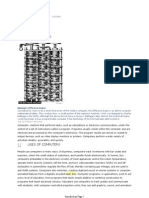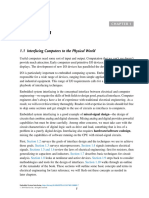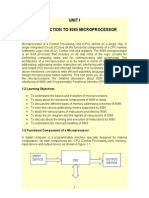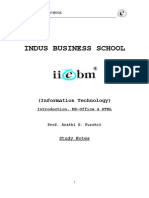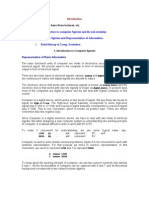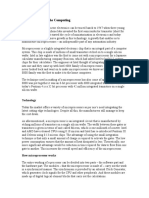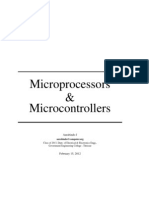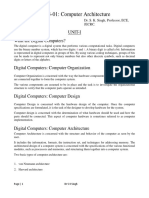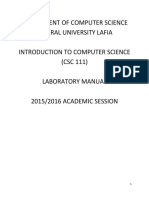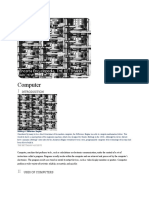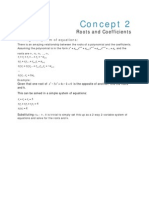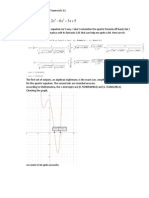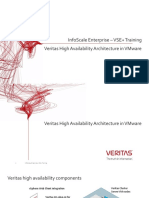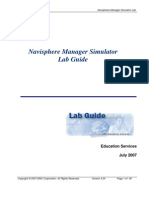Chapter 1
Chapter 1
Uploaded by
vincentliu11Copyright:
Available Formats
Chapter 1
Chapter 1
Uploaded by
vincentliu11Copyright
Available Formats
Share this document
Did you find this document useful?
Is this content inappropriate?
Copyright:
Available Formats
Chapter 1
Chapter 1
Uploaded by
vincentliu11Copyright:
Available Formats
J
J
a
a
v
v
a
a
M
M
e
e
t
t
h
h
o
o
d
d
s
s
Object-Oriented Programming
and
Data Structures
Maria Litvin
Phillips Academy, Andover, Massachusetts
Gary Litvin
Skylight Software, Inc.
Skylight Publishing
Andover, Massachusetts
Second AP
*
Edition
with GridWorld
Skylight Publishing
9 Bartlet Street, Suite 70
Andover, MA 01810
web: http://www.skylit.com
e-mail: sales@skylit.com
support@skylit.com
Copyright 2011 by Maria Litvin, Gary Litvin, and
Skylight Publishing
This material is provided to you as a supplement to the book
Java Methods, second AP edition You may print out one
copy for personal use and for face-to-face teaching for each
copy of the Java Methods book that you own or receive from
your school. You are not authorized to publish or distribute
this document in any form without our permission. You are
not permitted to post this document on the Internet. Feel
free to create Internet links to this documents URL on our
web site from your web pages, provided this document wont
be displayed in a frame surrounded by advertisement or
material unrelated to teaching AP
*
Computer Science or
Java. You are not permitted to remove or modify this
copyright notice.
Library of Congress Control Number: 2010915303
ISBN 978-0-9824775-7-1
*
AP and Advanced Placement are registered trademarks of The College Board, which was
not involved in the production of and does not endorse this book.
The names of commercially available software and products mentioned in this book are
used for identification purposes only and may be trademarks or registered trademarks
owned by corporations and other commercial entities. Skylight Publishing and the authors
have no affiliation with and disclaim any sponsorship or endorsement by any of these
product manufacturers or trademark owners.
Oracle, Java, and Java logos are trademarks or registered trademarks of Oracle Corporation
and/or its affiliates in the U.S. and other countries.
SCRABBLE
is the registered trademark of HASBRO in the United States and Canada and
of J.W. Spear and Sons, PLC, a subsidiary of Mattel, Inc., outside the United States and
Canada.
ch 001
1 An Introduction to Hardware,
Software, and the Internet
1.1 Prologue 1-2
1.2 Hardware Overview 1-5
1.2.1 The CPU 1-5
1.2.2 Memory 1-6
1.2.3 Secondary Storage Devices 1-7
1.2.4 Input and Output Devices 1-7
1.3 Software Overview 1-9
1.4 What Do Software Engineers Do? 1-10
1.5 Representation of Information in Computer Memory 1-14
1.5.1 Numbers 1-15
1.5.2 Characters 1-19
1.6 The Internet 1-21
1.7 Summary 1-23
Exercises
1-1
1-2 CHAPTER 1 ~ AN INTRODUCTION TO HARDWARE, SOFTWARE, AND THE INTERNET
1.1 Prologue
The most important piece of a typical computer is the Central Processing Unit or
CPU [1]. In a personal computer, the CPU is a microprocessor made from a tiny
chip of silicon, sometimes as small as half an inch square. Immensely precise
manufacturing processes etch a huge number of semiconductor devices, called
transistors, into the silicon wafer. Each transistor is a microscopic digital switch and
together they control, with perfect precision, billions of signals little spikes of
electricity that arise and disappear every second. The size of the spikes doesnt
matter, only their presence or absence. The transistors in the CPU recognize only
two states of a signal, on or off, high or low, 1 or 0, true or false.
This is called digital electronics (as opposed to analog electronics where the actual
amplitudes of signals carry information).
The transistors on a chip combine to form logical devices called gates. Gates
implement Boolean operations (named after the British mathematician George Boole,
1815-1864 [1] who studied the properties of logical relations). For example, an AND
gate takes two inputs and combines them into one output signal. The output is set to
true if both the first and the second input are true, and to false otherwise
(Figure 1-1-a). In an OR gate, the output is set to true if either the first or the
second (or both) inputs are true (Figure 1-1-b). A NOT gate takes one input and sets
the output to its opposite (Figure 1-1-c). Note the special shapes used to denote each
type of gate.
These three basic types of gates can be combined to make other Boolean operations
and logical circuits. Figure 1-2, for example, shows how you can combine AND,
OR, and NOT gates to make an XOR (eXclusive OR) operation. This operation sets
the output to true if exactly one of its two inputs is true. In the late 1940s, John
von Neumann, [1] a great mathematician and one of the founding fathers of computer
technology, showed that all arithmetic operations can be reduced to AND, OR, and
NOT logical operations.
1.1 ~ PROLOGUE 1-3
(a)
AND gate
A
B
A AND B
(b)
OR gate
(c)
NOT gate
A OR B
A
B
A NOT A
A B A AND B
T T T
T F F
F T F
F F F
A B A OR B
T T T
T F T
F T T
F F F
A NOT A
T F
F T
Figure 1-1. AND, OR, and NOT gates
A
B
A XOR B
A B A XOR B
T T F
T F T
F T T
F F F
Figure 1-2. XOR circuit made of AND, OR, and NOT gates
The microprocessor is protected by a small ceramic case mounted on a PC board
(Printed Circuit board) called the motherboard [1, 2]. Also on the motherboard are
memory chips. The computer memory is a uniform pool of storage units called bits.
A bit stores the smallest possible unit of information: on or off, 1 or 0. For
practical reasons, bits are grouped into groups of eight, called bytes.
1-4 CHAPTER 1 ~ AN INTRODUCTION TO HARDWARE, SOFTWARE, AND THE INTERNET
One byte is eight bits.
There is no other structure to memory: the same memory is used to store numbers
and letters and sounds and images and programs. All these things must be encoded,
one way or another, in sequences of 0s and 1s. A typical personal computer made in
the year 2010 had 2 to 4 gigs (gigabytes; 1 gigabyte is bytes) of
30 9
2 10 RAM
(Random-Access Memory) packed in a few SIMMs (Single In-Line Memory
Modules).
The CPU interprets and carries out computer programs, or sequences of instructions
stored in the memory. The CPU fetches the next instruction, interprets its operation
code, and performs the appropriate operation. There are instructions for arithmetic
and logical operations, for copying bytes from one location to another, and for
changing the order of execution of instructions. The instructions are executed in
sequence unless a particular instruction tells the CPU to jump to another place in
the program. Conditional branching instructions tell the CPU to continue with the
next instruction or jump to another place depending on the result of the previous
operation.
Besides the CPU, a general-purpose computer system also includes peripheral
devices [1] that provide input and output and secondary mass storage. In a laptop, the
peripheral devices are no longer quite so peripheral: a keyboard, a display, a hard
drive, a DVD drive, a wireless network adapter, a web cam (camera), a touch pad, a
microphone, and speakers are all built into one portable unit.
CPU, memory, peripherals all of this is called hardware. It is a lot of power
concentrated in a small device. But to make it useful, to bring life into it, you need
programs, software. Computer programs are also miracles of engineering, but of a
different kind: software engineering. They are not cast in iron, nor even silicon, but
in intangible texts that can be analyzed, modified, translated from one computer
language into another, copied into various media, transmitted over networks, or lost
forever. Software is to a computer as tunes are to a band: the best musicians will be
silent if they dont have music to play.
Take this amazing device with its software and connect it to the Internet, a network
of billions of computers of all kinds connected to each other via communication lines
of all kinds and running programs of all kinds, and you end up with a whole new
world. Welcome to cyberspace!
1.2 ~ HARDWARE OVERVIEW 1-5
In the rest of this chapter we will briefly discuss:
The main hardware components: CPU, memory, peripheral devices
What software is
How numbers and characters are represented in computer memory
What the Internet is
1.2 Hardware Overview
1.2.1 The CPU
What a CPU can do is defined by its instruction set and internal registers. The
registers are built-in memory cells that hold operands, memory addresses, and
intermediate results. Some of the registers are accessible to the programmer. The
instruction set includes instructions for loading CPU registers from memory and
storing their values into memory, for logical and arithmetic operations, and for
altering the sequence of operations.
Every computer has an internal clock that generates electrical pulses at a fixed
frequency. All CPU operations and their component steps are synchronized with the
clocks pulses; their duration is measured in clock cycles. The CPUs speed depends
on the frequency of the clock. The Intel 8088 microprocessor in the original IBM
Personal Computer (1981), for example, ran at 4.77 MHz (megahertz, or million
pulses per second). Thirty years and dozens of computer generations later, CPU
chips are pushing into the 3 GHz range (1 GHz, gigahertz, is equal to 1,000 MHz)
[1].
A microprocessor CPU connects to memory and to other devices through a set of
parallel lines (wires printed on the motherboard) controlled by digital electronics,
called a bus [1]. A CPU uses a separate address bus for specifying memory
addresses and a data bus for reading and writing memory values. Besides the
internal clock speed, the computers overall performance depends on the speed of the
bus transfers and the width of the bus. The Mac 512k computer [1], introduced in
September of 1984, had the Motorola MC68000 8-MHz CPU and a 16-bit bus
running at 8 MHz, so it could carry 16 bits of data concurrently from memory to the
CPU roughly at the same speed as the CPU could handle the data. The MacBook
released by Apple Computer Inc. in 2010 has a 64-bit bus running at around 1 GHz.
1-6 CHAPTER 1 ~ AN INTRODUCTION TO HARDWARE, SOFTWARE, AND THE INTERNET
1.2.2 Memory
Each byte of memory has a unique address that can be used to fetch the value stored
in the byte or write a new value into it. A CPU does not have to read or write
memory bytes sequentially: bytes can be accessed in any arbitrary order. This is why
computer memory is called random-access memory or RAM. This is similar to a CD
where you can choose any track to play, as opposed to a tape that has to be played in
sequence.
Table 1-1 shows units used to describe memory size. (Powers of 2 have a special
significance in computer technology for a reason that will become clear shortly.)
Name Abbrev. Bytes Equals
Kilobyte KB
10
2 1, 024 =
Megabyte MB
20
2 1,048,576 = 1024 KB
Gigabyte GB
30 9
2 1,073,741,824 10 = 1024 MB
Terabyte TB
40 12
2 10 1024 GB
Petabyte PB
50 15
2 10 1024 TB
Table 1-1. Memory units
In the early days, designers of personal computers thought 64KB of RAM would
suffice for the foreseeable future. An additional hardware mechanism, the segment
registers, had to be added to the later versions of Intels microprocessors to access a
larger memory space, up to one megabyte, while maintaining compatibility with the
old programs. But the one megabyte limit very quickly proved inadequate too. A
32-bit memory address bus allows programs to directly address four gigabytes (GB)
of memory. This is becoming a bottleneck as computers beginning to appear with
8GB of RAM.
A small part of the computer memory is permanent non-erasable memory, known as
read-only memory or ROM. ROM contains, among other things, the initialization
code that boots up the operating system (that is, loads into memory the boot record or
initialization code from the disk and passes control to it).
1.2 ~ HARDWARE OVERVIEW 1-7
An executable program has to be loaded from a hard disk or another
peripheral device (or from the Internet) into RAM before it can run.
ROM solves the first-program dilemma some program must already be running
to load any other program into memory. The operating system is a program that has
the job of loading and executing other programs. In a personal computer, ROM also
contains the computer configuration program and hardware diagnostic programs that
check various computer components. The ROM BIOS (Basic Input Output System)
contains programs for controlling the keyboard, display, disk drives, and other
devices. A special small memory EPROM (Erasable Programmable ROM)
preserves system configuration data when the power is off.
1.2.3 Secondary Storage Devices
A computers RAM has only limited space, and its contents are wiped out when the
power is turned off. All the programs and data in a computer system have to be
stored in secondary mass storage. The auxiliary storage devices include hard disks,
CD-ROM drives, USB flash drives, and other devices. A hard disk can hold
hundreds of gigabytes and even terabytes. A CD-ROM can hold more than 700 MB
(or up to 2 or 3 GB with data compression). Access to data on these devices is much
slower than access to RAM.
The operating system software organizes the data in secondary storage into files. A
file may contain a set of related data, a program, a document, an image, and so on; it
has a unique name. The operating system maintains a directory of file names,
locations, sizes, dates and times of the last updates, and other attributes.
Thus a file is not a hardware but rather a software concept.
When a program is running, it can read and write data directly to and from files
stored on secondary storage devices.
1.2.4 Input and Output Devices
A personal computer receives user input through the keyboard and displays the
output on the computer display (also called the monitor). In many programs the input
is echoed on the screen as you type, creating the illusion that the keyboard is directly
connected to the monitor. In fact these are two entirely different devices connected
only through the CPU and the currently running program. The keyboard sends to the
program digital codes that represent the pressed keys. The program captures these
1-8 CHAPTER 1 ~ AN INTRODUCTION TO HARDWARE, SOFTWARE, AND THE INTERNET
codes and takes appropriate actions, which may include displaying corresponding
characters on the screen.
The screen is controlled by a video adapter and displays the contents of special video
memory in the adapter, called VRAM. VRAM is addressable by the CPU and may
contain codes, colors and attributes of characters when running in text modes, or
colors or intensities of individual pixels (picture elements) in graphics modes. The
original IBM PC ran mostly in the text mode. You dont see the text mode much any
more everything is in graphics now, except diagnostic and setup programs.
A mainframe computer [1, 2] (a very large multi-user computer) may have hundreds
of terminals attached to it. The terminals send keystrokes and receive commands and
character codes from the computer through digital transmission lines.
Printers, plotters, digitizing tablets, scanners, and other devices receive commands
and data from the computer in digital form and may send data or control codes back
to the computer according to a specific communications protocol.
Network adapters and modems are essential for getting your computer connected to
other computers. Network adapters and cables are used to connect several computers
into a LAN (Local Area Network), which in turn may be connected to the Internet.
Special data acquisition devices equipped with A/D (analog-to-digital) converters [1]
allow computers to convert an electrical signal into digital form by frequently
sampling the amplitude of the signal and storing the digitized values in memory. D/A
(digital-to-analog) converters perform the reverse transformation: they generate
electrical currents from the digitized amplitudes stored in the computer. These
devices allow the computer to receive data from all kinds of instruments and to serve
as a universal control device in industrial applications and scientific experiments.
Input and output devices are connected to the computer via hardware interface
modules that implement specific data transfer protocols. In a personal computer, the
interfaces may be built into the motherboard or take the form of special adapter cards
that plug into special sockets on the motherboard, called extension slots. Devices
connected to the computer are usually controlled by special programs called drivers
that handle all the details and peculiarities of the device and the data transfer
protocol. Todays personal computers are equipped with several USB (Universal
Serial Bus) ports, used for connecting virtually all peripheral devices: mice, printers,
digital cameras, external disk drives, and so on. A high-speed USB interface can
handle a data transmission rate of up to 480 megabits per second. (The emerging
Superspeed USB 3.0 will increase the transmission rate tenfold.)
1.3 ~ SOFTWARE OVERVIEW 1-9
1.3 Software Overview
The term software refers to computer programs; it is also used as an adjective to refer
to tasks or functions implemented through programs, as in software interface,
software fonts, and so on. The line between hardware and software is not always
clear. In the modern world, microprocessors are embedded in many objects, from
microwave ovens and DVD players to cars and satellites. Their programs are
developed using simulation tools on normal computers; when a program is finalized,
it is permanently burned into ROMs. Such programs are referred to as firmware.
A modern computer not only runs individual programs but also maintains a software
environment. This environment involves several functional layers (Figure 1-3).
The bottom layer in this environment comprises BIOS, device drivers, interrupt
handlers, etc. programs that directly support hardware devices and functions. The
next layer is the operating system, a software program that provides computer access
services to users and standard support functions to other programs. The top layer is
software applications (word processors, Internet browsers, business, industrial, or
scientific applications, games, etc.).
BIOS, device drivers
Operating system
Software applications
Figure 1-3. Software functional layers
The operating system loads programs into RAM from secondary storage and runs
them. On a mainframe, the operating system allows multiple users to work on the
computer at once through time sharing. In such a multi-user system, one user may be
slowly editing a file or entering data on a terminal using only a small fraction of the
available CPU time. At the same time another program may be doing number
crunching. A multi-user operating system allocates time slices to each program
and automatically switches between them. The operating system prioritizes the jobs
1-10 CHAPTER 1 ~ AN INTRODUCTION TO HARDWARE, SOFTWARE, AND THE INTERNET
and swaps segments of programs in and out of memory as needed. A personal
computer assumes one user, but contemporary users enjoy multi-tasking operating
systems that let them keep several programs active concurrently (for example, a word
processor, an e-mail program, and a music player).
The operating system also establishes and maintains a file system in secondary
storage. Files are organized into a branching structure of directories and
subdirectories (also called folders). The operating system provides commands and
utility programs for navigating through the directory tree. Part of the operating
system is a set of routines (sets of instructions, callable from other programs) that
provide standard service functions to programs. These include functions for creating,
reading, and writing files. The operating system shell provides a set of user
commands, including commands for displaying, copying, deleting, and printing files,
executing programs, and so on. Modern operating systems use GUI (Graphical User
Interface, pronounced gooey), where commands can be entered by selecting items
in menus or by clicking a mouse on an icon that represents a command or an object
graphically.
The top layer of software consists of application programs that make computers
useful to people. In the old days, application programs mostly performed
calculations or processed files. If interaction with the user was required, it was
accomplished via an unsophisticated text dialog: a computer would display questions
(or prompts) in plain text and let the user enter responses, then print out the resulting
numbers, tables, or reports. Such applications are called console applications. In a
modern computing environment, users expect programs to have GUI. Menus,
buttons, and icons select different functions in the program; dialog boxes and text-
edit fields are used to set options and enter data or text. The shift from console
applications to GUI applications has brought changes in the way programs are
designed and written and brought about new software development tools and
methodologies, such as OOP (Object-Oriented Programming).
1.4 What do Software Engineers Do?
Dont they write computer software? In brief, yes, of course. But this simple answer
no longer explains what the computer programming (or, to sound more lofty,
software engineering) profession has become. Software professionals create
intricate and immensely complex invisible and intangible worlds. These worlds have
their laws, their architectures, their aesthetics. These worlds also have windows
into the real world. So many different skills are involved that computer
programming has become one of the most versatile and demanding professions. We
are not talking about specific technical skills, listed by cryptic acronyms in a typical
employment ad for a software engineer. They are important, of course, but they are
1.4 ~ WHAT DO SOFTWARE ENGINEERS DO? 1-11
changing so rapidly that many programmers just learn them on the job. What we are
talking about are the core skills that define the profession.
The most important skill is, probably, the ability to absorb new technical information
all the time and to put it to work. In no other technical field are things changing so
fast. Some of the changes are driven by new hardware and the new capabilities it
provides; others by user demands, and some simply by fashion.
A programmer also needs to be an architect. Computers manipulate data and follow
specific instructions written by a programmer. To make a computer perform useful
tasks, a programmer must represent both the data and the instructions in coherent
structures and procedures. Consider, for example, a word processor application.
Before you proceed to write code for it, you need to have an abstract model of a
document. You consider: a document may have text, drawings, images, links, and
so on. The user has to be able to edit a document, cut and paste pieces, and so on.
Each of these elements and procedures must be reflected in the structure of your
program. Sound software design makes it easier to implement and test the program,
modify it when necessary, share the work among a team of programmers, and reuse
pieces of the software in future projects.
Programmers are not building cities, bridges, or cathedrals, of course, and you wont
find pieces of computer software exhibited in a museum. Very few people in the
world will be able to examine the software structures that a programmer creates. But
if you could enter and walk around software systems, you would find all kinds of
things, from rather elegant structures to huge monstrosities, often barely standing,
with pieces held together by the software equivalent of string and duct tape. A small
change in one place upsets the whole structure; more strings and tape and props
become necessary to prevent the contraption from collapsing. Perhaps these
specimens do belong in a museum after all! For better or worse, software remains
mostly invisible, hidden behind thousands of lines of code. It is mysterious,
sometimes even full of surprises (Figure 1-4).
Another important skill: a programmer needs to be able to understand algorithms and
devise his own. An algorithm is a more or less abstract, formal, and general
step-by-step recipe that tells how to perform a certain task or solve a certain problem
on a computer. We will discuss algorithms in Chapter 4.
1-12 CHAPTER 1 ~ AN INTRODUCTION TO HARDWARE, SOFTWARE, AND THE INTERNET
Figure 1-4. In Excel 97, if you pressed Ct r l - G, typed L97: X97, pressed
Ent er , pressed Tab, and then clicked on the Chart Wizard icon while holding
the Shi f t and Ct r l keys down, a toy Flight Simulator popped up. Expert flying
eventually revealed a monolith with the names of the product development team
scrolling on it. Such a hidden feature is called an Easter Egg [1].
The next programmers skill is using programming languages. People often refer to
programmers as a C++ programmer, a Java programmer, and so on. They think
that knowing a particular programming language is what the programming profession
is about. This is not so. First, a programmer is likely to encounter several
programming languages over his or her career. Second, as we have seen, a
programming job has many different aspects, and mastering a particular language is
just one of them.
Still, ultimately a programmer needs to be able to express his or her brilliant
structural designs and clever algorithms in a written program. A program written in a
high-level language must obey the very precise syntax rules of that language and
must also follow less precise but as important stylistic conventions established among
professionals. We discuss Java syntax and style in Chapter 5.
But even when a program compiles with no errors, there is no guarantee that it works
as desired. It may show unexpected behavior, produce incorrect output, or just crash.
The programmer then has to figure out what is wrong and fix the problem. This takes
yet another important skill: solving mysteries. A programmer must analyze the
behavior of the program, hypothesize what may be wrong, either in the algorithm or
in the code, then verify his hypothesis and make corrections. Of course, there are
software tools, called debuggers, that help programmers locate bugs (errors) in their
programs. But it would be too slow and tedious to use a debugger for every little
error. Like a good doctor, a good programmer must develop an intuition for
diagnosing and locating bugs quickly.
1.4 ~ WHAT DO SOFTWARE ENGINEERS DO? 1-13
Believe it or not, there was time when programmers wrote their programs on paper
and sent them to keypunch operators who would put them on punch cards [1]. Now
programmers use sophisticated software development tools. Being able to use these
tools proficiently is another skill in the programmers skill set.
In addition to general tools, a development environment for a particular programming
language includes libraries of pre-programmed and pre-tested reusable software
modules. There is no way to remember their technical details, of course. For
example, in the 6.0 release, the standard Java library documentation consisted of
12,485 files in 844 folders and took 289 MB of disk space (which is roughly
equivalent to 150,000 pages). Luckily the documentation is well organized and
available online, so programmers can quickly find the information they need. But
like a librarian, a programmer must know where and how to look.
Sometimes programmers forget that there are other people in the world who are not
programmers, and that programs are written mostly for those other people, users.
A programmer must make sure that his or her software is user-friendly, that is, easy
to use and appears logical and intuitive to a non-technical user. Designing a friendly
and effective user interface is another very important programming skill. A good
user interface designer knows how to lay out screens, use colors, sound, animation,
menus, keyboard commands, printouts and reports, and so on. The user interface is
the only part of your software that is visible to the outside world, and this is often
how your program is judged by non-technical users.
Last but not least, programmers must be familiar with the ethical codes for their
profession and strive to uphold the highest professional ethical standards (see
Appendix F).
To summarize, these are some of the things that a programmer must be able to do:
Absorb and use emerging technical information
Create sound software system architectures
Understand and devise effective algorithms
Be proficient with the syntax and style of programming languages
Diagnose and correct programming errors
Use software development tools and documentation
Find and utilize reusable software components
Design and implement friendly user interfaces
Uphold the highest standards of professional ethics
1-14 CHAPTER 1 ~ AN INTRODUCTION TO HARDWARE, SOFTWARE, AND THE INTERNET
Of course, when we said A programmer must be able to do this; a programmer
should know that, we meant an abstract programmer who does not exist in the real
world. In reality, a number of people are involved in every software development
project, and different people may possess different skills. One person may specialize
in designing system architectures, another person may be good at devising complex
algorithms, a third person can quickly write and debug code, while someone else may
not know much about programming but be an excellent designer of user interfaces.
In the software development enterprise, there is a need for different types of work
and room for people with different interests and skills.
The discipline that focuses on all aspects of software development is called computer
science. A computer scientist takes a more theoretical view of one or another aspect
of software development, looking for general ways to improve the efficiency of
algorithms or for better software development methodologies and new programming
languages. Unlike the computer scientist, a software engineer (or programmer)
works on specific software development projects.
1.5 Representation of Information in Computer Memory
Computer memory is a uniform array of bytes that does not privilege any particular
type of information. The memory can contain CPU instructions, numbers and text
characters, and any other information that can be represented in digital form. Since a
suitable analog/digital (A/D) converter can fairly accurately convert any electrical
signal to digital form, any information that can be carried over a wire can be
represented in computer memory. This includes sounds, images, motion, and so on
(but, so far, excludes taste and smell).
CPU instructions are represented in computer memory in a manner specific to each
particular brand of CPU. The first byte or two represent the operation code that
identifies the instruction and the total number of bytes in that instruction; the
following bytes may represent the values or memory addresses of the operands. How
memory addresses are represented depends on the CPU architecture, but they are
basically numbers that indicate the absolute sequential number of the byte in
memory. A CPU may have special index registers that help calculate the actual
address in memory for a specified instruction or operand.
The format for numbers is mostly dictated by the CPU, too, because the CPU has
instructions for arithmetic operations that expect numbers to be represented in a
certain way. Characters (letters, digits, etc.) are represented using one of the several
character code systems that have become standard not only for representing text
inside computers but also in computer terminals, printers, and other devices. The
code assigns each character a number.
1.5 ~ REPRESENTATION OF INFORMATION IN COMPUTER MEMORY 1-15
Fortunately, high-level programming languages, such as Java, shield computer
programmers from the intricacies of how to represent CPU instructions, memory
addresses, numbers, and characters.
Representing other types of information is often a matter of a specific applications
design. A black-and-white image, for example, may be represented as a sequence of
bytes where each bit represents a pixel of the image: 0 for white and 1 for black. The
sequence of pixels typically goes from left to right along each horizontal line of the
image and then from top to bottom by row. Other memory locations may hold
numbers that represent the image dimensions.
1.5.1 Numbers
Integers from 0 to 255 can be represented in one byte using the binary (base-2)
system as follows:
Deci mal Bi nar y
0 00000000
1 00000001
2 00000010
3 00000011
4 00000100
5 00000101
6 00000110
7 00000111
8 00001000
9 00001001
10 00001010
. . . . . .
252 11111100
253 11111101
254 11111110
255 11111111
1-16 CHAPTER 1 ~ AN INTRODUCTION TO HARDWARE, SOFTWARE, AND THE INTERNET
If we use 2 bytes (16 bits), we can represent integers from 0 to 2
16
1 = 65535:
Deci mal Bi nar y
0 00000000 00000000
1 00000000 00000001
2 00000000 00000010
. . . . . .
65534 11111111 11111110
65535 11111111 11111111
In general, k bits can produce 2
k
different combinations of 0s and 1s. Therefore, k
bits used as binary digits can represent non-negative integers in the range from 0 to
2
k
1. A 32-bit memory address can identify 2
32
= 4,294,967,296 different memory
locations. So if we want to be able to address each individual byte, 32-bit addresses
cover 4 GB of memory space.
CPUs perform all their arithmetic operations on binary numbers. A CPU may have
instructions that perform 8-bit, 16-bit, or 32-bit arithmetic, for instance. Since it is
difficult for a human brain to grasp long sequences of 0s and 1s, programmers who
have to deal with binary data often use the hexadecimal (or simply hex)
representation in their documentation and programs. The hex system is the base-16
system, which uses 16 digits. The first ten digits are the usual 0 through 9, with the
eleventh through sixteenth digits represented by the letters A through F. A byte can
be split into two four-bit quads; each quad represents one hex digit, as follows:
Deci mal Bi nar y Hex
0 0000 0
1 0001 1
2 0010 2
3 0011 3
4 0100 4
5 0101 5
6 0110 6
7 0111 7
8 1000 8
9 1001 9
10 1010 A
11 1011 B
12 1100 C
13 1101 D
14 1110 E
15 1111 F
1.5 ~ REPRESENTATION OF INFORMATION IN COMPUTER MEMORY 1-17
Experienced programmers remember the bit patterns for the sixteen hex digits and
can easily convert a binary number into hex and back. It is often convenient to use
hex representation as an intermediate step for converting numbers from binary to
decimal and back. For example:
700
10
= 2 16
2
+ 11 16 + 12 = 2BC
16
= 001010111100
2
1101101
2
= 6D
16
= 6 16 + 13 = 109
10
2 B C
6 D
The following examples show a few numbers represented in the decimal, hex, and
16-bit binary systems:
Decimal Hex Binary
0 0000 00000000 00000000
1 0001 00000000 00000001
12 000C 00000000 00001100
32 0020 00000000 00100000
128 0080 00000000 10000000
255 00FF 00000000 11111111
256 0100 00000001 00000000
32767 7FFF 01111111 11111111
32768 8000 10000000 00000000
65535 FFFF 11111111 11111111
For a software developer, knowing the hex system is a matter of cultural literacy. In
practice, programmers who use a high-level programming language, like Java, dont
have to use it very often and there are calculators and programs that can do
conversions.
What about negative numbers? The same bit pattern may represent an unsigned
(positive) integer and a negative integer, depending on how a particular instruction
interprets it. Suppose we use 32-bit binary numbers, but now we decide that they
represent signed integers. Positive integers from 0 to 2
31
1 can be represented as
before. These use only the 31 least significant bits. As to negative integers, their
representation may be machine-dependent, varying from CPU to CPU. Many CPUs,
including the Intel family, use a method called twos-complement arithmetic. In this
method, a negative integer x in the range from 1 to 2
31
is represented the same way
as the unsigned binary number
32
2 x where x is the absolute value of x. For
example, 21 and - 21 will be represented as:
1-18 CHAPTER 1 ~ AN INTRODUCTION TO HARDWARE, SOFTWARE, AND THE INTERNET
00000000 00000000 00000000 00010101 = 21
10
11111111 11111111 11111111 11101011 = - 21
10
Real numbers are represented using one of the standard formats expected by the CPU
(or a separate floating-point arithmetic unit). Like scientific notation, this
representation consists of a fractional part (mantissa) and an exponent part, but here
both parts are represented as binary numbers. The IEEE (Institute of Electrical and
Electronics Engineers) standard for a 4-byte (32-bit) representation uses 1 bit for the
sign, 8 bits for the exponent and 23 bits for the mantissa. 127 is added to the
exponent to ensure that negative exponents are still represented by non-negative
numbers. This format lets programmers represent numbers in the range from
approximately 3.410
38
to 3.410
38
with at least seven digits of precision.
Figure 1-5 gives a few examples.
Implied
binary point
Implicit high-order
bit of mantissa
always 1
23 bi t s 8 bi t s
3: 0 10000000
1.
10000000000000000000000
+ 1+127=128 1. 1
13: 1 10000010
1.
10100000000000000000000
3+127=130 1. 101
1.1
2 2
1
= 11
2
= 3
10
1.101
2
2
3
= 1101
2
= 13
10
3/ 4: 0 01111110
1.
10000000000000000000000
+ 1+127=126 1. 1
1.1
2
2
1
= 11
2
2
2
= 3/4
10
Mantissa
Sign
Exponent
(+ 127)
Figure 1-5. IEEE standard representation of 32-bit
floating-point numbers
1.5 ~ REPRESENTATION OF INFORMATION IN COMPUTER MEMORY 1-19
There are dozens of applets on the Internet that illustrate binary representation of
numbers and conversions from decimal to binary.
1.5.2 Characters
Characters are represented by numeric codes. These days most applications use
platform-independent Unicode standard for encoding characters [1]. For example,
the reason you can see the sentence written in Russian
[1] is that the software that displays this document
understands the Unicode representation of Cyrillic characters.
Java programs use Unicode internally for representing characters and
text strings.
Unicode uses two bytes per character. It can encode up to 65,000 characters, enough
to encode the alphabets of most world languages and many special characters.
Unicode has a provision to extend the character set even further, into millions of
different codes.
In the old days, the two most common character codes were EBCDIC (Extended
Binary Coded Decimal Interchange Code) [1], used in IBM mainframes, and ASCII
(American Standard Code for Information Interchange, pronounced as'-kee), used in
personal computers, printers and other devices. Both of these use one byte per
character. In the PC world, the term ASCII file refers to a text file (in which
characters are represented in ASCII code), as opposed to a binary file that may
contain numbers, images, or any other digitized information. Normally you wont
find EBCDIC-encoded data on a PC unless the file originated on a mainframe.
Unicode includes ASCII codes as a subset (called C0 Controls and Basic Latin [1].
ASCII code defines 128 characters with codes from 0 to 127 and uses only the seven
least-significant bits of a byte. Codes from 33 to 127 represent printable
characters: digits, upper- and lowercase letters, punctuation marks, and so on. 32
(hex 20) is a space.
The first 32 ASCII codes (0-31) are reserved for special control codes. For example,
code 13 (hex 0D) is carriage return (CR), 10 (hex 0A) is line feed (LF), 12 (hex
0C) is form feed (FF) and 9 (hex 09) is horizontal tab (HT). How control codes
are used may depend to some extent on the program or device that processes them. A
standard ASCII table, including the more obscure control codes, is presented in
Figure 1-6.
1-20 CHAPTER 1 ~ AN INTRODUCTION TO HARDWARE, SOFTWARE, AND THE INTERNET
Hex 0_ 1_ 2_ 3_ 4_ 5_ 6_ 7_
_0 0 16 32 48 64 80 96 112
NUL DEL ( SPACE) 0 @ P ` p
_1 1 17 33 49 65 81 97 113
SOH DC1 ! 1 A Q a q
_2 2 18 34 50 66 82 98 114
STX DC2 " 2 B R b r
_3 3 19 35 51 67 83 99 115
ETX DC3 # 3 C S c s
_4 4 20 36 52 68 84 100 116
EOT DC4 $ 4 D T d t
_5 5 21 37 53 69 85 101 117
ENQ NAK % 5 E U e u
_6 6 22 38 54 70 86 102 118
ACK SYN & 6 F V f v
_7 7 23 39 55 71 87 103 119
BEL ETB ' 7 G W g w
_8 8 24 40 56 72 88 104 120
BS CAN ( 8 H X h x
_9 9 25 41 57 73 89 105 121
HT EM ) 9 I Y i y
_A 10 26 42 58 74 90 106 122
LF SUB * : J Z j z
_B 11 27 43 59 75 91 107 123
VT ESC + ; K [ k {
_C 12 28 44 60 76 92 108 124
FF FS , < L \ l |
_D 13 29 45 61 77 93 109 125
CR GS - = M ] m }
_E 14 30 46 62 78 94 110 126
SO RS . > N ^ n ~
_F 15 31 47 63 79 95 111 127
SI US / ? O _ o ( NUL)
Figure 1-6. ASCII code used in personal computers and printers
1.6 ~ THE INTERNET 1-21
1.6 The Internet
You basically need three things to make computers talk to each other:
1. A wire (or in more recent technology, a radio) link between them;
2. Hardware adapters at each host (the term used for a computer connected to a
network), switches at the network junctions, and other hardware that controls
the network;
3. A common language, called a protocol, so that the hosts can understand each
other.
Of the three, the protocol is probably the most important. Once a reliable and
flexible protocol is designed, the hardware and the connections will somehow follow
and fall into place. Actually a protocol standard defines hundreds, even thousands of
distinct protocols that function at many different levels, or, as network designers say,
layers. (Figure 1-7).
The protocols in the bottom layer deal directly with the hardware the network
technology itself and various devices that are connected to it: switches, high-speed
adapters, routers, and so on. These hardware protocols are constantly evolving due to
changing and competing new technologies and standards set by manufacturers and
professional organizations.
Network technology:
switches, adapters, routers
Internetworking: routing and
forwarding data to destinations
(IP)
Transport: delivering data
reliably and securely (TCP)
Applications: www, e-mail, ftp,
instant messaging
Figure 1-7. TCP/IP protocols in layered network architecture
1-22 CHAPTER 1 ~ AN INTRODUCTION TO HARDWARE, SOFTWARE, AND THE INTERNET
The next layer deals with routing and forwarding: how to make sure that the
information from one host eventually reaches another host. These internetworking
protocols must know about the general layout of the network (who is connected to
whom), and be efficient and robust for reliable connections. The Internets
internetworking layer is called IP (the Internet Protocol).
The layer above internetworking, the transport protocol, is responsible for properly
handling information from specific applications used on the network and for meeting
the requirements of these applications: reliability, security, data compression, and so
on. TCP (the Transmission Control Protocol) is the Internets transport protocol.
The TCP/IP combination is what really defines the Internet.
Finally, at the very top layer, there are protocols for network applications such as
e-mail (using SMTP Simple Mail Transfer Protocol), the World Wide Web (using
HTTP HyperText Transfer Protocol), file transfer (using FTP File Transfer
Protocol), instant messaging, remote terminal emulation (telnet), and other
applications.
If we had to set a birth date for the Internet, it would probably be early September
1969 when the first computer network was tested. The network had only four nodes:
University of California in Los Angeles (UCLA), Stanford Research Institute (SRI),
University of California in Santa Barbara (UCSB), and the University of Utah in Salt
Lake City. Here is how Dr. Leonard Kleinrock [1], a computer science professor at
UCLA and one of the Internet pioneers, describes the event. Kleinrock and his group
of graduate students hoped to log onto the Stanford computer and try to send it some
data. They would start by typing login and seeing if the letters appeared on the
remote terminal.
We set up a telephone connection between us and the guys at SRI...We typed the L
and we asked on the phone, Do you see the L? Yes, we see the L, came the
response. We typed the O, and we asked, Do you see the O. Yes, we see the O.
Then we typed the G, and the system crashed! Yet a revolution had begun. [1]
More precisely, the worlds first instance of host-to-host, packet-switched data
communications between networked computers had taken place.
The Internet has certainly made a lot of headway since. In 2010, over 75 percent of
people in the United States and almost 2 billion people worldwide (28.7%) were
online [1]. The best way to explore the Internet and its history is certainly not
through a book, but by getting online and browsing [1, 2]. A browser is a program
that helps its user navigate through the Internet and presents the information that
comes from the Internet back to the user. Firefox and Internet Explorer are the two
most popular browsers [1]. Information comes from the Internet in many different
formats. The most common one is HTML documents text files with embedded
1.7 ~ SUMMARY 1-23
formatting tags in them. You can find a basic HTML tutorial in Appendix C. Other
files use standard formats for representing images, sounds, and so on. A browser and
its helper modules, called plug-ins, know how to handle different formats of data and
show (or play) the data to the user.
In a matter of just a few years the Internet has become a vast repository of knowledge
and information (and misinformation) of all kinds and from all sources. It would be
very difficult to find anything in this ocean without some guidance. Portals are
popular web sites that arrange a large number of Internet links by category and help
users navigate to the subjects they need. Search engines are programs based on large
Internet data centers that analyze and index the contents of web pages and find web
sites relevant to user queries.
As more and more individuals and businesses use computing services and resources
on remote servers over the Internet, a new trend is rapidly emerging: cloud
computing. Cloud computing may refer to different things. In its simplest form it
can mean using a calendar or a calculator that runs on a remote web site or using a
word processor or spreadsheet software remotely through the Internet and keeping
your documents on a remote server, too, so that you can access them anywhere from
any computer. Cloud computing can also mean structuring a whole enterprises
information technology needs around remote services provided by a third party
vendor.
The idea is that with the Internet, computing companies become services like water
and electricity are delivered to your home or business in quantity that you need. That
way a business does not have to invest in expensive hardware and software; it just
buys a service that meets its needs and can be easily scaled up or down according to
the demand. Not everyone knows, for example, that amazon.com, besides selling
books and consumer goods, sells cloud computing services through its Amazon Web
Services (AWS) division [1]. Netflix, a popular movie delivery company, is an
AWSs customer.
1.7 Summary
Digital electronics represents information using two states: on or off, high or
low, 1 or 0. Digital devices, called gates, implement simple logical operations
on signals: AND, OR, NOT. All other logical and arithmetic operations can be
implemented using these three simple operations.
The heart of a computer is a CPU (central processing unit) that can perform logical
and arithmetic operations. An executable program is a sequence of CPU instructions
in machine code. It must be loaded into RAM (random-access memory) before it can
1-24 CHAPTER 1 ~ AN INTRODUCTION TO HARDWARE, SOFTWARE, AND THE INTERNET
run. All instructions and data addresses are encoded in binary sequences of 0s and
1s. The CPU fetches instructions and data from RAM, interprets operation codes,
and executes the instructions.
RAM is arranged into bytes; each byte is 8 bits; each bit can hold either 1 or 0. The
size of RAM is measured in kilobytes (1 KB = 2
10
= 1024 bytes), megabytes
(1 MB = 2
20
= 1,048,576 bytes), or gigabytes (1 GB is over one billion bytes). The
contents of RAM are erased when the power is turned off.
Mass storage devices have a larger memory capacity hundreds of gigabytes or
terabytes (1 TB is over one trillion bytes) and they can hold the information
permanently, but access to them is slower. Data in mass storage is arranged into files
by the operating system software. The files are stored in a branching system of
directories (represented as folders). The operating system also loads and runs
applications, provides a GUI (graphical user interface) to users, and provides system
services to programs (such as reading and writing files, supporting input devices,
etc.).
All kinds of information are represented in the computer memory as sequences of 0s
and 1s. Integers are represented as binary numbers. Real numbers use standard
floating-point binary representation. Characters are represented as their codes in one
of the standard coding systems. The most common codes are ASCII and Unicode.
The latter includes thousands of characters from virtually all world alphabets.
The Internet is a network of millions of computers connected in many different ways.
The Internet is based on the TCP/IP (Transmission Control Protocol / Internet
Protocol), which controls information routing on the network and supports various
network applications. Higher-level protocols are used in Internet applications such as
e-mail, the World Wide Web, file transfer, and remote terminal emulation. A
browser is a program on your computer that processes your requests for Internet
connections and delivers and displays the received Internet information, web pages in
particular. Portals are popular web sites that list many Internet links, arranged by
category. Search engines are Internet indexing services that collect and index
information from the Internet and help you find web sites relevant to your requests.
Exercises
The exercises for this chapter are in the book (Java Methods: Object-Oriented
Programming and Data Structures, 2nd AP Edition, ISBN 978-0-9824775-7-1,
Skylight Publishing, 2011 [1]).
You might also like
- System Design Document - Design SpecificationDocument5 pagesSystem Design Document - Design SpecificationNonkululeko Zibani100% (2)
- 1 &2 Pra-CmtsDocument5 pages1 &2 Pra-CmtsDev PatelNo ratings yet
- T Is A Computer Harware Softwares Fundamentals and PartsDocument21 pagesT Is A Computer Harware Softwares Fundamentals and Partslhieeyhan77No ratings yet
- LAB02Document23 pagesLAB02زياد عبدالله عبدالحميد100% (1)
- Describe The Operation of Timing and Control BlockDocument4 pagesDescribe The Operation of Timing and Control BlockTamayo Arrianna MurielNo ratings yet
- CF Lab Rep 1 (Hardware)Document10 pagesCF Lab Rep 1 (Hardware)TeedeeNo ratings yet
- Ece 8085 Microprocessor PDF ReportDocument19 pagesEce 8085 Microprocessor PDF Reportgourav VermaNo ratings yet
- Handouts For Lab 1Document13 pagesHandouts For Lab 1Aafaaq AmirNo ratings yet
- Computer IntroductionDocument19 pagesComputer IntroductionmaddabdulNo ratings yet
- Interfaceintro 1Document4 pagesInterfaceintro 1Aliaa Tarek AliNo ratings yet
- Unit I Introduction To 8085 MicroprocessorDocument55 pagesUnit I Introduction To 8085 Microprocessorkiran sharmaNo ratings yet
- Chapter 1: Introduction To Computer Organization and ArchitectureDocument5 pagesChapter 1: Introduction To Computer Organization and ArchitectureSteffany Roque100% (1)
- COM111 Introduction To ComputingDocument36 pagesCOM111 Introduction To Computingabass muyiwaNo ratings yet
- Hardware Interview QuestionsDocument44 pagesHardware Interview QuestionsChandrashekar HkNo ratings yet
- TLE 7 - Week 2Document6 pagesTLE 7 - Week 2Kevin AlibongNo ratings yet
- Computing Fundamentals AssignmentDocument11 pagesComputing Fundamentals AssignmentMary Jane Evardone EspinoNo ratings yet
- Unit I Introduction To 8085 MicroprocessorDocument55 pagesUnit I Introduction To 8085 Microprocessorsheriffwoody123No ratings yet
- Designing A PC Based Oscilloscope Using Arduino-1557Document3 pagesDesigning A PC Based Oscilloscope Using Arduino-1557neneanaieNo ratings yet
- Introduction To Computers MS-Office NotesDocument72 pagesIntroduction To Computers MS-Office NotesPrerit Gangwal100% (2)
- Computer Hardware Network Professional Ver.2013Document345 pagesComputer Hardware Network Professional Ver.2013Aqeel AhmadNo ratings yet
- Q1 Lesson1-4Document40 pagesQ1 Lesson1-4Xhialvea KeziahNo ratings yet
- COMPUTER ARCHITECTURE (CHAPTER 1n2)Document24 pagesCOMPUTER ARCHITECTURE (CHAPTER 1n2)Akono PrincesseNo ratings yet
- 03 CS132 Intro To Comp Systems Week 3 CITU Roden UgangDocument60 pages03 CS132 Intro To Comp Systems Week 3 CITU Roden UgangskewNo ratings yet
- Lab Manual Computer Organization and Hardware MaintenanceDocument28 pagesLab Manual Computer Organization and Hardware Maintenanceanshroy7373No ratings yet
- Computer Hardware Maintanance Repair1Document32 pagesComputer Hardware Maintanance Repair1wolefpcloudNo ratings yet
- Modern CPU ArchitectureDocument18 pagesModern CPU Architecturebulusabashi122No ratings yet
- COA NotesDocument5 pagesCOA NoteslazygurramNo ratings yet
- A Brief Computer HistoryDocument6 pagesA Brief Computer HistoryMalachi LamaNo ratings yet
- The Brain Behind The Computing: TechnologyDocument3 pagesThe Brain Behind The Computing: TechnologykarmaNo ratings yet
- ICOSDocument24 pagesICOSqasimalijutt713No ratings yet
- Charles Darwin University: HIT332: Embedded and Mobile Systems Casuarina CampusDocument13 pagesCharles Darwin University: HIT332: Embedded and Mobile Systems Casuarina CampusNguyen Anh ThangNo ratings yet
- Microprocessors & Microcontrollers: Aurabindo JDocument21 pagesMicroprocessors & Microcontrollers: Aurabindo Jmelquiades7007No ratings yet
- Task 3Document2 pagesTask 3Camille SampangNo ratings yet
- Question No. - 1 (A) : SolutionDocument41 pagesQuestion No. - 1 (A) : SolutionShivangi Maheshwari100% (1)
- Hard 1Document34 pagesHard 1Marques Butler100% (1)
- Eee250 Module 1-7Document101 pagesEee250 Module 1-72023641418No ratings yet
- Learning Outcomes: After Undergoing The Subject, The Students Will Be Able ToDocument16 pagesLearning Outcomes: After Undergoing The Subject, The Students Will Be Able Toprabhakarchoudhary2612No ratings yet
- Introduction To Computer System: Representation of Basic InformationDocument11 pagesIntroduction To Computer System: Representation of Basic InformationMd Saif UddinNo ratings yet
- Overview of A Computer System.Document32 pagesOverview of A Computer System.grenamoNo ratings yet
- 23 Computer Application Commerce Unit-02Document42 pages23 Computer Application Commerce Unit-02jikku thomasNo ratings yet
- UNIT-IV ME 5th SEM Mechtronics NotesDocument77 pagesUNIT-IV ME 5th SEM Mechtronics NotesDeepak PrajapatiNo ratings yet
- Lec 1 - Lec2 Introduction - & EvolutionDocument15 pagesLec 1 - Lec2 Introduction - & EvolutionKimani MaithyaNo ratings yet
- ITE 111 Module 1-4Document5 pagesITE 111 Module 1-4Hax GamingNo ratings yet
- Computer SystemDocument10 pagesComputer Systemdhirendra lamsalNo ratings yet
- 04 Compter HardwareDocument12 pages04 Compter HardwareragulanNo ratings yet
- Noter Maskinær ProgrammeringDocument30 pagesNoter Maskinær ProgrammeringPeter JuulNo ratings yet
- 5EC3-01: Computer Architecture: Unit-I What Are Digital Computers?Document19 pages5EC3-01: Computer Architecture: Unit-I What Are Digital Computers?Himanshi SainiNo ratings yet
- Chapter 1 2Document23 pagesChapter 1 2tahirchaima88No ratings yet
- Computer Performancce IdeasDocument29 pagesComputer Performancce IdeasLathaNo ratings yet
- CCPS Module - 1Document77 pagesCCPS Module - 1sofia janitNo ratings yet
- IntroductionDocument20 pagesIntroductionlaithismail200018No ratings yet
- Itc 102 Module 1Document7 pagesItc 102 Module 1Lehd OnlaoNo ratings yet
- Practical 1Document13 pagesPractical 1swan htetpyNo ratings yet
- BNSL 112 Block 1 WWW - Khoji.net 7506Document206 pagesBNSL 112 Block 1 WWW - Khoji.net 7506Priya SinghNo ratings yet
- Unit-5 COADocument54 pagesUnit-5 COASAURAV CHAUDHARYNo ratings yet
- XICS-QBDocument28 pagesXICS-QBsriram.s2111No ratings yet
- CSC 111 Practical Lab ManualDocument49 pagesCSC 111 Practical Lab ManualLawal100% (1)
- CAHMDocument20 pagesCAHMadityasharma001No ratings yet
- Computer: Babbage's Difference EngineDocument17 pagesComputer: Babbage's Difference EnginekandilidineshNo ratings yet
- A Microprocessor Is One of The Most Exciting Technological InnovationsDocument16 pagesA Microprocessor Is One of The Most Exciting Technological InnovationsTrixieNo ratings yet
- Concept 4: Solving Polynomial or Rational InequalitiesDocument2 pagesConcept 4: Solving Polynomial or Rational Inequalitiesvincentliu11No ratings yet
- Concept 3: Review: Polynomial and Rational Function FittingDocument2 pagesConcept 3: Review: Polynomial and Rational Function Fittingvincentliu11No ratings yet
- Concept 2: Roots and CoefficientsDocument1 pageConcept 2: Roots and Coefficientsvincentliu11No ratings yet
- Concept 1: Upper and Lower BoundsDocument2 pagesConcept 1: Upper and Lower Boundsvincentliu11No ratings yet
- CrapDocument8 pagesCrapvincentliu11No ratings yet
- Practical No 6Document10 pagesPractical No 6sayedshaad02100% (1)
- Megadisk Manual v112Document15 pagesMegadisk Manual v112Nestor PraslinNo ratings yet
- VSE+InfoScale Enterprise Veritas High Availability Architecture in VMware 2019 10Document27 pagesVSE+InfoScale Enterprise Veritas High Availability Architecture in VMware 2019 10ymlvNo ratings yet
- Resume Sample For A Postgraduate (Fresher)Document2 pagesResume Sample For A Postgraduate (Fresher)Sanjeet KathuriaNo ratings yet
- Importance of C & C++Document4 pagesImportance of C & C++Lalit JainNo ratings yet
- Long - Fresher CV TemplateDocument3 pagesLong - Fresher CV TemplateBình HiếuNo ratings yet
- Seatools SSD Gui Guide 100837824 EDocument57 pagesSeatools SSD Gui Guide 100837824 ETiffano JatiNo ratings yet
- MIT16 842F15 Ses 8 Sys IntDocument42 pagesMIT16 842F15 Ses 8 Sys IntssvivekanandhNo ratings yet
- Recap - 3 12Document19 pagesRecap - 3 12api-537058125No ratings yet
- CSE 1101 - 2019-20 1st Year 1stDocument2 pagesCSE 1101 - 2019-20 1st Year 1stannahian44No ratings yet
- Oasis Montaj Getting StartedDocument14 pagesOasis Montaj Getting Startedxavier toledoNo ratings yet
- 1.1 Computer Graphics:: Flowing FountainDocument32 pages1.1 Computer Graphics:: Flowing FountaingururajaNo ratings yet
- Parallel To MIPI CSI-2 TX Bridge: January 2015 Reference Design RD1183Document13 pagesParallel To MIPI CSI-2 TX Bridge: January 2015 Reference Design RD1183enes yükselNo ratings yet
- Mag 3 D ManualDocument61 pagesMag 3 D ManualAminNo ratings yet
- FT Dvpower Rmoh Series Rev1Document7 pagesFT Dvpower Rmoh Series Rev1Ulyyszesz AalvaaraadooNo ratings yet
- Comandos para DSDocument294 pagesComandos para DSAndré MenezesNo ratings yet
- Introduction To Microsoft DOS I (Command Prompt) : Handout ObjectivesDocument16 pagesIntroduction To Microsoft DOS I (Command Prompt) : Handout ObjectiveskaytaurusNo ratings yet
- Navisphere Manager Simulator Lab Guide 3.24Document49 pagesNavisphere Manager Simulator Lab Guide 3.24Shaik Nagoor0% (1)
- Rhino Modeling Workflows in ArchitectureDocument115 pagesRhino Modeling Workflows in ArchitecturelorielemonlimeNo ratings yet
- Geolog 6.6 Connect TutorialDocument59 pagesGeolog 6.6 Connect TutorialPradityan Febri YudhistiraNo ratings yet
- CentOS 4.4 System Administration GuideDocument352 pagesCentOS 4.4 System Administration GuideHadi BaghdadiNo ratings yet
- HS - 4 - Lesson - 1 - Function - of - Operating - SystemDocument1 pageHS - 4 - Lesson - 1 - Function - of - Operating - SystemIlex AradillosNo ratings yet
- 1.2.4.4 Packet Tracer - Representing The Network InstructionsDocument6 pages1.2.4.4 Packet Tracer - Representing The Network InstructionsShantam100% (1)
- ICDL Module 1 IT Concepts PDFDocument33 pagesICDL Module 1 IT Concepts PDFAsad MalikNo ratings yet
- SAGE Profile V6.3.2 User Manual - Volume 2Document73 pagesSAGE Profile V6.3.2 User Manual - Volume 2GodwinNo ratings yet
- Topic 3 DSS Methodologies and Technologies-V2Document28 pagesTopic 3 DSS Methodologies and Technologies-V2tofuNo ratings yet
- Simics Unleashed - Applications of Virtual Platforms 2013Document197 pagesSimics Unleashed - Applications of Virtual Platforms 2013Wei ZhuangNo ratings yet
- William Cartwright Multimedia Cartography LengkapDocument561 pagesWilliam Cartwright Multimedia Cartography LengkapAstri Haniefah100% (1)








